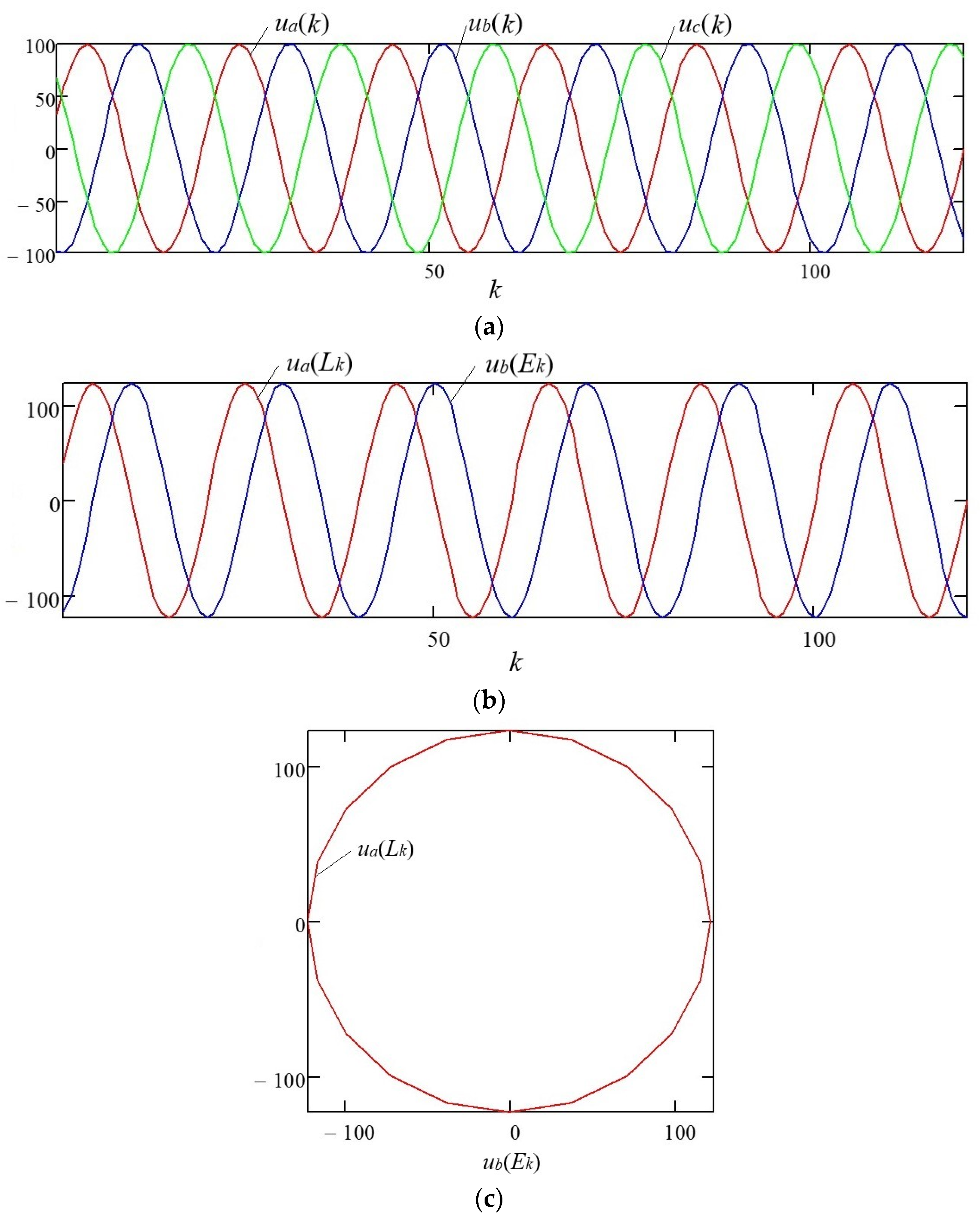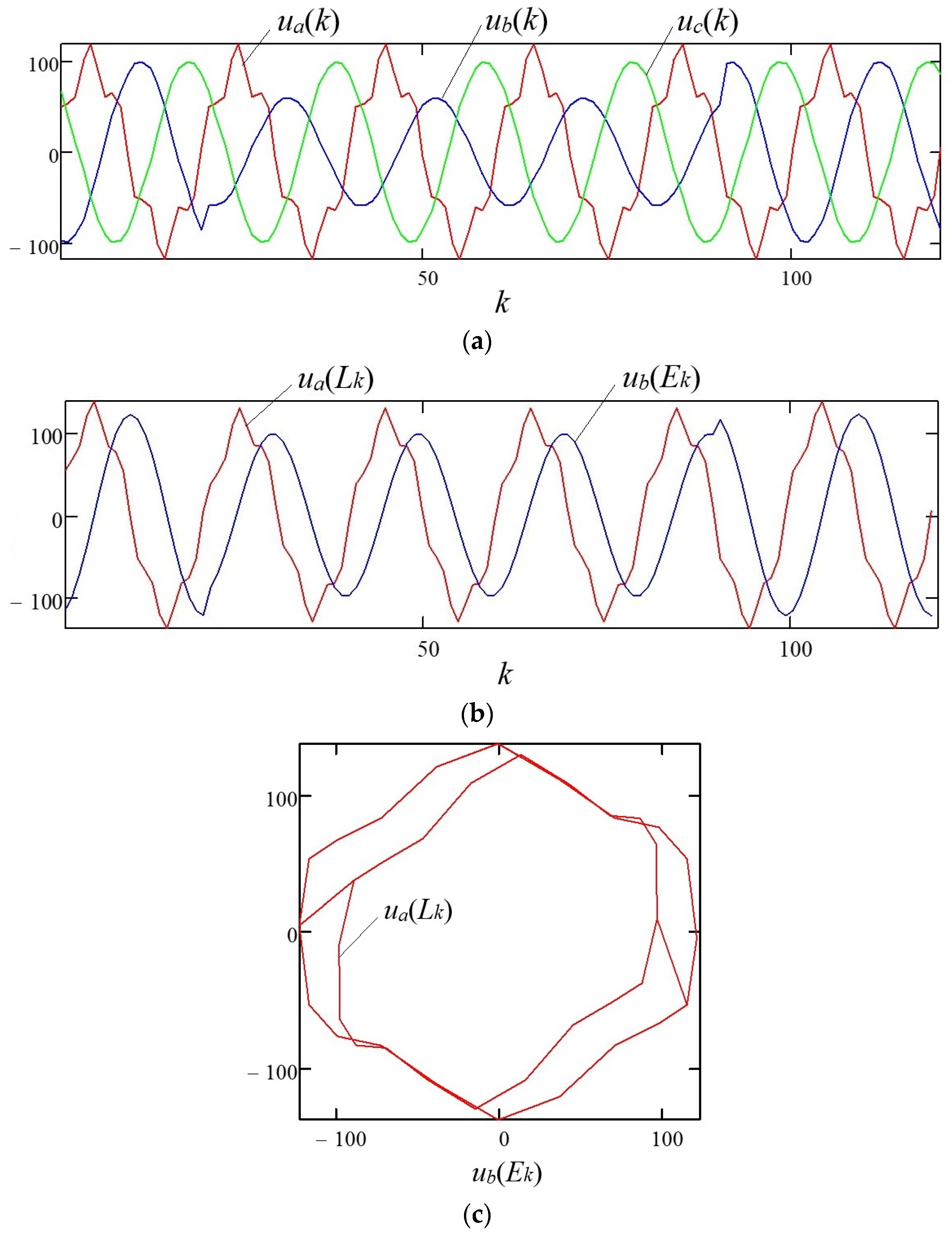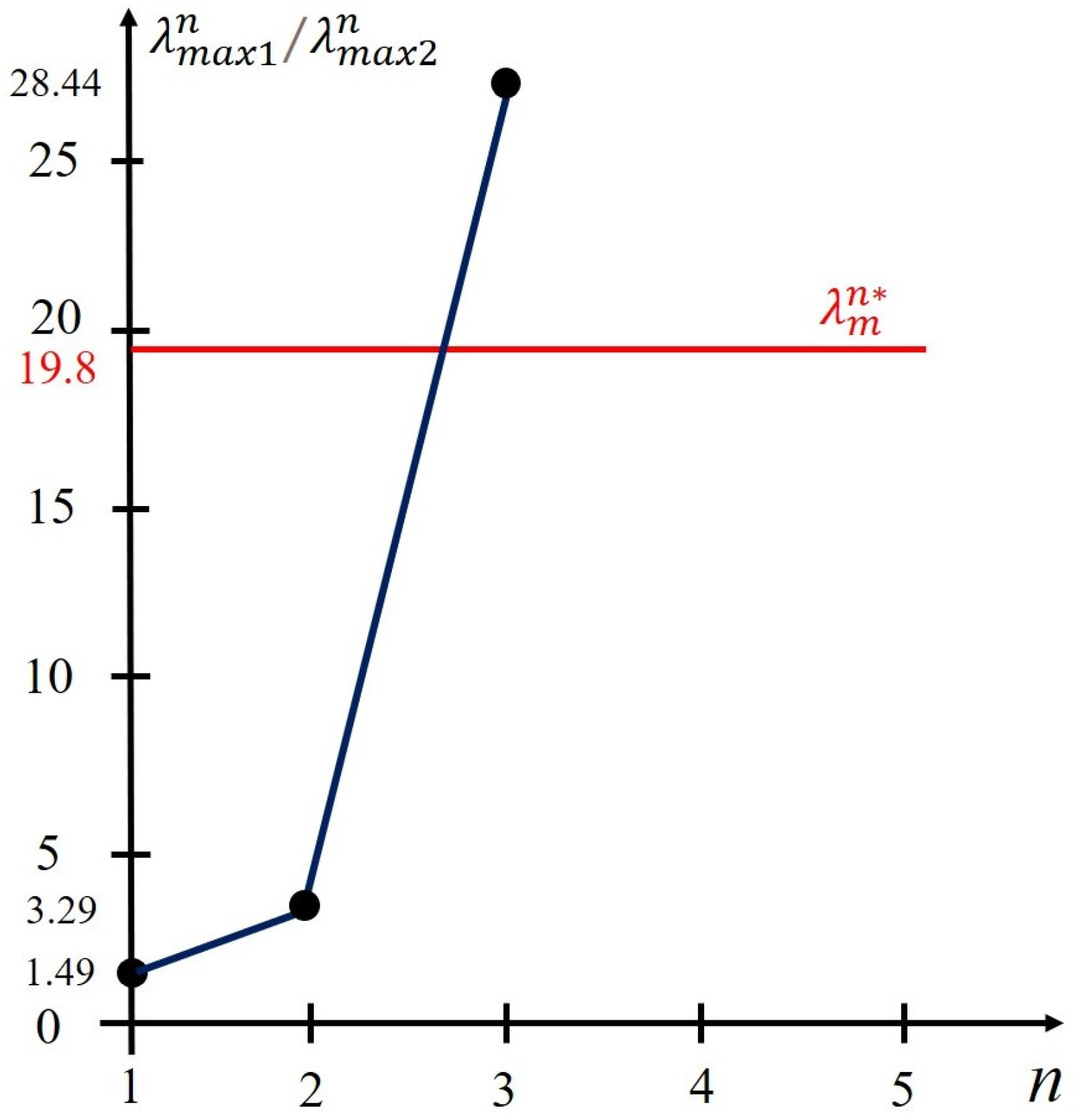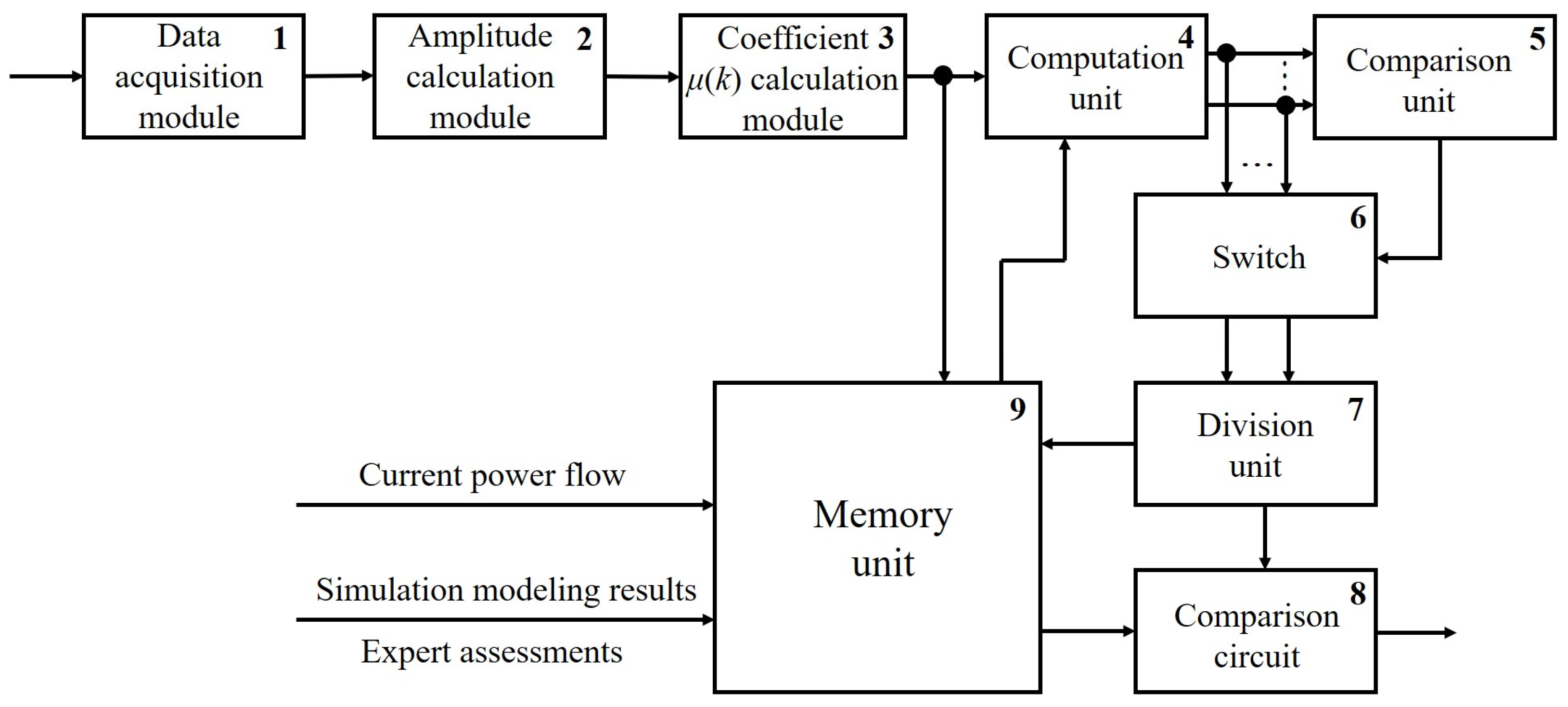Estimation of an Extent of Sinusoidal Voltage Waveform Distortion Using Parametric and Nonparametric Multiple-Hypothesis Sequential Testing in Devices for Automatic Control of Power Quality Indices
Abstract
1. Introduction
- Upsets of production processes, defective products, and economic damages associated with disruption of the normal functioning of essential electrical loads;
- Increases in electricity losses;
- A rise in electricity consumption for the same production processes;
- A reduction in the reliability of both the systems of power supply to industrial consumers and the electrical equipment.
2. State-of-the-Art Literature Review
- Mathematical morphology [33];
- Decision trees [34];
- Statistical analysis [39];
- Logistic regression [40];
- Principal component analysis [41];
- K-nearest neighbors method [42];
- Wald’s sequential analysis [43];
- The potential capabilities for classifying PQI deviations from standard values in the event of complex emergency disturbances (distortions of sinusoidal voltage waveforms) and the impact of noise and interference [50];
- The volumes of necessary calculations and their high speed required when implementing PQI control devices based on software and hardware platforms;
- The amount of memory required to store simulation results and other information for making decisions on classification of PQI deviations from standard values [51];
- The organization of special digital processing of current and voltage signals [52];
- The magnitude of the error in classifying various PQI deviations from standard values;
- Other factors.
- Each power supply system of an industrial consumer has its specific relationship between the amount of damage and the depth and duration of the voltage dip [55];
- Voltage dips in external power supply networks, which are random in nature, are often accompanied by PQI deviations from standard values, including distortions of the sinusoidal voltage waveform, the presence of noise and interference.
3. Materials and Methods
4. Results and Discussion
- Calculate M likelihood ratio at each step n of the procedure by Expression (18):where random x is the value regarding which a multiple-hypothesis decision is made; m = 1, 2, …, M; and are probability densities for the random variable x corresponding to hypotheses m and 1; hypothesis m = 1 corresponds to the interval of smallest values of μ and the extent of three-phase voltage distortion not exceeding 5% (Table 1);
- Determine the two largest of M likelihood ratio values at each step n ( and ), and select hypotheses corresponding to these likelihood ratios;
- Determine threshold values for each of the selected hypotheses, using Expression (19):where is the probability of correct classification of hypothesis m;
- Calculate ratio of to and compare it with the threshold value :with threshold ;
- Make a decision about the validity of hypothesis m using Expression (20) provided that:otherwise, make a decision to continue observations.
- The sequential assessment of the extent of the sinusoidal voltage waveform distortion leads to the adoption of the hypothesis of a 15% distortion of the coefficient μ, which corresponds to an unacceptable amount of damage for an industrial consumer;
- The procedure for multiple-hypothesis sequential testing by Palmer’s algorithm is completed at step 3, which does not require significant time expenditure and has virtually no effect on the performance of the automatic PQI control device;
- The speed of decision making in multiple-hypothesis sequential testing with Palmer’s algorithm depends on the degree of distortion of the sinusoidal voltage waveform, including PQI deviations from standard values.
- Calculate the average value of the random variable x at step n of sequential testing:
- Determine the minimum distance dmin, which for an L-dimensional random variable can be found by Expression (29):
- Classify the extent of the sinusoidal voltage waveform distortion by comparing it with hypothesis m:and by comparing the value dmin with the threshold Am(n), dmin ≤ Am(n);
- Check if the condition dmin ≤ Am(n) is met, otherwise continue sequential analysis.
- The sequential assessment of the extent of the sinusoidal voltage waveform distortion based on the nearest neighbor method, as in the case of using Palmer’s algorithm, leads to the acceptance of the hypothesis of a 15% distortion of coefficient μ;
- The multiple-hypothesis sequential testing procedure is completed at Step 3 (Figure 11), which does not require significant time, therefore, there is no need to introduce an adaptive threshold to increase the speed of the algorithm;
- The advantage of the multiple-hypothesis sequential testing based on the nearest neighbor method is that there is no need to use statistics and distributions in the calculation process.
Future Research Directions
5. Conclusions
Author Contributions
Funding
Data Availability Statement
Conflicts of Interest
References
- Luo, F.; Ge, N.; Xu, J. Power Supply Reliability Analysis of Distribution Systems Considering Data Transmission Quality of Distribution Automation Terminals. Energies 2023, 16, 7826. [Google Scholar] [CrossRef]
- Petrova, R.; Gracheva, E.; Valtchev, S.; Miftakhova, N. Methods for assessing the reliability of in-shop power supply. Vestn. MSTU 2023, 26, 395–409. [Google Scholar] [CrossRef]
- Praiselin, W.J.; Edward, J.B. A review on impacts of power quality, control and optimization strategies of integration of renewable energy based microgrid operation. Int. J. Intell. Syst. Appl. 2018, 10, 67–81. [Google Scholar] [CrossRef]
- Kulikov, A.L.; Shepovalova, O.V.; Ilyushin, P.V.; Filippov, S.P.; Chirkov, S.V. Control of electric power quality indicators in distribution networks comprising a high share of solar photovoltaic and wind power stations. Energy Rep. 2022, 8, 1501–1514. [Google Scholar] [CrossRef]
- Dong, F.; Qin, C.; Zhang, X.; Zhao, X.; Pan, Y.; Gao, Y.; Zhu, J.; Li, Y. Towards carbon neutrality: The impact of renewable energy development on carbon emission efficiency. Int. J. Environ. Res. Public Health 2021, 18, 13284. [Google Scholar] [CrossRef]
- Zhang, H. Technology innovation, economic growth and carbon emissions in the context of carbon neutrality: Evidence from BRICS. Sustainability 2021, 13, 11138. [Google Scholar] [CrossRef]
- Wang, C.; Jiang, Y.; Guo, H.; Bai, K.; Zhang, X.; Wang, A. A joint clearing model for the participation of renewable energy and energy storage in the frequency modulation ancillary service market considering performance differences. Front. Energy Res. 2023, 11, 1332041. [Google Scholar] [CrossRef]
- Ribeiro, P.F.; Duque, C.A.; Silveira, P.M.; Cerqueira, A.S. Power Systems Signal Processing for Smart Grids; John Wiley & Sons Ltd.: Chichester, UK, 2014. [Google Scholar]
- Kuboń, M.; Skibko, Z.; Tabor, S.; Malaga-Toboła, U.; Borusiewicz, A.; Romaniuk, W.; Zarajczyk, J.; Neuberger, P. Analysis of Voltage Distortions in the Power Grid Arising from Agricultural Biogas Plant Operation. Energies 2023, 16, 6189. [Google Scholar] [CrossRef]
- Ilyushin, P.; Filippov, S.; Kulikov, A.; Suslov, K.; Karamov, D. Specific Features of Operation of Distributed Generation Facilities Based on Gas Reciprocating Units in Internal Power Systems of Industrial Entities. Machines 2022, 10, 693. [Google Scholar] [CrossRef]
- Lesnykh, V.V.; Timofeyeva, T.B.; Petrov, V.S. Problems of the Assessment of Economic Damage Caused by Power Supply Interruption. Econ. Reg. 2017, 13, 847–858. [Google Scholar] [CrossRef]
- Ilyushin, P.; Volnyi, V.; Suslov, K.; Filippov, S. Review of Methods for Addressing Challenging Issues in the Operation of Protection Devices in Microgrids with Voltages of up to 1 kV that Integrates Distributed Energy Resources. Energies 2022, 15, 9186. [Google Scholar] [CrossRef]
- Ilyushin, P.; Volnyi, V.; Suslov, K.; Filippov, S. State-of-the-Art Literature Review of Power Flow Control Methods for Low-Voltage AC and AC-DC Microgrids. Energies 2023, 16, 3153. [Google Scholar] [CrossRef]
- Mishra, S.; Anderson, K.; Miller, B.; Boyer, K.; Warren, A. Microgrid resilience: A holistic approach for assessing threats, identifying vulnerabilities, and designing corresponding mitigation strategies. Appl. Energy 2020, 264, 114726. [Google Scholar] [CrossRef]
- Kulikov, A.L.; Ilyushin, P.V.; Suslov, K.V.; Karamov, D.N. Coherence of digital processing of current and voltage signals at decimation for power systems with a large share of renewable power stations. Energy Rep. 2022, 8, 1464–1478. [Google Scholar] [CrossRef]
- Kłosowski, Z.; Mazur, Ł. Influence of the Type of Receiver on Electrical Energy Losses in Power Grids. Energies 2023, 16, 5660. [Google Scholar] [CrossRef]
- Sinchuk, O.; Strzelecki, R.M.; Beridze, T.; Peresunko, I.; Baranovskyi, V.; Kobeliatskyi, D.; Zapalskyi, V. Model studies to identify input parameters of an algorithm controlling electric supply/consumption process by underground iron ore enterprises. Min. Miner. Depos. 2023, 17, 93–101. [Google Scholar] [CrossRef]
- Rakhmonov, I.; Berdishev, A.; Khusanov, B.; Khaliknazarov, U.; Utegenov, U. General characteristics of networks and features of electricity consumers in rural areas. IOP Conf. Ser. Mater. Sci. Eng. 2020, 883, 012104. [Google Scholar] [CrossRef]
- 32144-2013; Electrical Energy. Electromagnetic Compatibility of Technical Equipment. Standards for Electric Power Quality in Public Power Supply Systems. Standartinform Publishing: Moscow, Russia, 2014; 15p.
- EN 50160; Voltage Characteristics of Electricity Supplied by Public Electricity Networks. CENELEC: Brussels, Belgium, 2010.
- Byk, F.; Myshkina, L. Comparison and choice of measures to improve the reliability of distribution grid companies. In Proceedings of the 2nd International Conference on Industrial Engineering, Applications and Manufacturing (ICIEAM), Chelyabinsk, Russia, 19–20 May 2016. [Google Scholar] [CrossRef]
- Cao, Y. Study on the interaction of vehicle-to-grid and its impact on power quality of electric grid. J. Phys. Conf. Ser. 2023, 2649, 012007. [Google Scholar] [CrossRef]
- Ignatova, V.; Granjon, P.; Bacha, S. Space vector method for voltage dips and swells analysis. IEEE Trans. Power Deliv. 2009, 24, 2054–2061. [Google Scholar] [CrossRef]
- Palmer, L.C. Sequential tests to select among M hypotheses. IEEE Trans. Inf. Theory 1972, 18, 211–214. [Google Scholar] [CrossRef]
- Basholli, F.; Daberdini, A. Monitoring and assessment of the quality of electricity in a building. Eng. Appl. 2023, 2, 32–48. [Google Scholar]
- Zhang, X.J.; Xu, Y.H.; Xiao, X.N. Power quality disturbance detection and identification based on dq conversion and wavelet transform. Electr. Power Autom. Equip. 2005, 25, 1–5. [Google Scholar]
- Zhao, F.; Rengang, Y. Power quality disturbance recognition using S-transform. IEEE Trans. Power Deliv. 2007, 22, 944–950. [Google Scholar] [CrossRef]
- Balouji, E.; Salor, O. Classification of power quality events using deep learning on event images. In Proceedings of the 3rd International Conference on Pattern Recognition and Image Analysis (IPRIA), Shahrekord, Iran, 19–20 April 2017; pp. 216–221. [Google Scholar] [CrossRef]
- Ma, J.; Zhang, J.; Xiao, L.; Chen, K.; Wu, J. Classification of power quality disturbances via deep learning. IETE Tech. Rev. 2016, 34, 408–415. [Google Scholar] [CrossRef]
- Sun, L.; Lang, L.; Zhong, W.; Liu, H.; Dong, Y. A Fast Mismatch Calibration Method Based on Frequency Domain Orthogonal Decomposition for Time-Interleaved Analog-to-Digital Converters. Electronics 2023, 12, 5042. [Google Scholar] [CrossRef]
- Cong, J. The Use of Wavelet Modulus Maximum Principle in the Detection of Disturbance Signal for Transient Power Quality. Northeast Electr. Power Technol. 2009, 30, 10–13. [Google Scholar]
- Chilukuri, M.V.; Dash, P.K. Multiresolution S-transform-based fuzzy recognition system for power quality events. IEEE Tran. Power Deliv. 2004, 19, 323–330. [Google Scholar] [CrossRef]
- Ling, L.; Xu, Z. Mathematical Morphology Based Detection and Classification of Dynamic Power Quality Disturbances. Power Syst. Technol. 2006, 30, 62–66. [Google Scholar]
- Khoa, N.M.; Dai, L.V. Detection and Classification of Power Quality Disturbances in Power System Using Modified-Combination between the Stockwell Transform and Decision Tree Methods. Energies 2020, 13, 3623. [Google Scholar] [CrossRef]
- Lu, G.; Cheng, H.; Zheng, J.; Wang, X. Power Quality Disturbances Detection and Identification Based on S-Transform and Multi-Lay SVMs. Trans. China Electrotech. Soc. 2006, 21, 121–126. [Google Scholar]
- Axelberg, P.G.V.; Gu, I.Y.H.; Bollen, M.H.J. Support Vector Machine for classification of voltage disturbances. IEEE Trans. Power Deliv. 2007, 22, 1297–1303. [Google Scholar] [CrossRef]
- Ghosh, A.K.; Lubkeman, D.L. The classification of power system disturbance waveforms using a neural network approach. IEEE Trans. Power Deliv. 1990, 10, 671–683. [Google Scholar] [CrossRef]
- Zhao, Y.; Xu, Y.; Xiao, X.; Zhu, Y.; Guo, C. Power Quality Disturbances Identification Based on dq Conversion, Wavelet Transform and FFT. In Proceedings of the 2010 Asia-Pacific Power and Energy Engineering Conference, Chengdu, China, 28–31 March 2010. [Google Scholar] [CrossRef]
- Kulikov, A.L.; Ilyushin, P.V.; Sevostyanov, A.A. Statistical Sampling for Power-Quality Monitoring in Modern Power-Supply Systems. Russ. Electr. Eng. 2022, 93, 254–260. [Google Scholar] [CrossRef]
- Kostadinov, D.; Taskovski, D. Automatic voltage disturbance detection and classification using wavelets and multiclass logistic regression. In Proceedings of the 2012 IEEE International Instrumentation and Measurement Technology Conference (I2MTC), Graz, Austria, 13–16 May 2012; pp. 103–106. [Google Scholar] [CrossRef]
- Zhang, M.; Zhan, Y.; He, S. Power Quality Data Compression Based on Iterative PCA Algorithm in Smart Distribution Systems. Smart Grid Renew. Energy 2017, 8, 366–378. [Google Scholar] [CrossRef]
- Qu, X.; Dong, K.; Zhao, J.; Yu, Y. An Identification and Location Method for Power Quality Disturbance Sources in MMC Converter Based on KNN Algorithm. In Proceedings of the 4th International Conference on Energy, Electrical and Power Engineering (CEEPE), Chongqing, China, 23–25 April 2021. [Google Scholar] [CrossRef]
- Kleijnen, J.P.C.; Shi, W. Sequential probability ratio tests: Conservative and robust. Simulation 2020, 97, 33–43. [Google Scholar] [CrossRef]
- Ibrahim, W.R.A.; Morcos, M.M. Artificial intelligence and advanced mathematical tools for power quality applications: A survey. IEEE Power Eng. Rev. 2002, 21, 11. [Google Scholar] [CrossRef]
- Granados-Lieberman, D.; Romero-Troncoso, R.J.; Osornio-Rios, R.A.; Garcia-Perez, A.; Cabal-Yepez, E. Techniques and methodologies for power quality analysis and disturbances classification in power systems: A review. IET Gener. Transm. Distrib. 2011, 5, 519–529. [Google Scholar] [CrossRef]
- Zhao, L.C.; Zou, H.X.; Wei, K.X.; Zhou, S.X.; Meng, G.; Zhang, W.M. Mechanical Intelligent Energy Harvesting: From Methodology to Applications. Adv. Energy Mater. 2023, 13, 2300557. [Google Scholar] [CrossRef]
- Zhao, L.C.; Zou, H.X.; Zhao, Y.J.; Wu, Z.Y.; Liu, F.R.; Wei, K.X.; Zhang, W.M. Hybrid energy harvesting for self-powered rotor condition monitoring using maximal utilization strategy in structural space and operation process. Appl. Energy 2022, 314, 118983. [Google Scholar] [CrossRef]
- Akhtar, S.; Adeel, M.; Iqbal, M.; Namoun, A.; Tufail, A.; Kim, K.H. Deep learning methods utilization in electric power systems. Energy Rep. 2023, 10, 2138–2151. [Google Scholar] [CrossRef]
- Ibrahim, B.; Rabelo, L.; Sarmiento, A.T.; Gutierrez-Franco, E. A Holistic Approach to Power Systems Using Innovative Machine Learning and System Dynamics. Energies 2023, 16, 5225. [Google Scholar] [CrossRef]
- Ilyushin, P.V.; Filippov, S.P. Under-frequency load shedding strategies for power districts with distributed generation. In Proceedings of the 2019 International Conference on Industrial Engineering, Applications and Manufacturing (ICIEAM), Sochi, Russia, 25–29 March 2019. [Google Scholar] [CrossRef]
- Volodina, O.V.; Skvortsov, A.A.; Nikolaev, V.K. Memory computing based on thermal memory elements. E3S Web of Conf. 2023, 458, 01009. [Google Scholar] [CrossRef]
- Ilyushin, P.V.; Shepovalova, O.V.; Filippov, S.P.; Nekrasov, A.A. The effect of complex load on the reliable operation of solar photovoltaic and wind power stations integrated into energy systems and into off-grid energy areas. Energy Rep. 2022, 8, 1515–1529. [Google Scholar] [CrossRef]
- Ilyushin, P.; Filippov, S.; Kulikov, A.; Suslov, K.; Karamov, D. Intelligent Control of the Energy Storage System for Reliable Operation of Gas-Fired Reciprocating Engine Plants in Systems of Power Supply to Industrial Facilities. Energies 2022, 15, 6333. [Google Scholar] [CrossRef]
- Shamarova, N.; Suslov, K.; Ilyushin, P.; Shushpanov, I. Review of Battery Energy Storage Systems Modeling in Microgrids with Renewables Considering Battery Degradation. Energies 2022, 15, 6967. [Google Scholar] [CrossRef]
- Vinogradov, A.; Bolshev, V.; Vinogradova, A.; Jasi´nski, M.; Sikorski, T.; Leonowicz, Z.; Goňo, R.; Jasińska, E. Analysis of the Power Supply Restoration Time after Failures in Power Transmission Lines. Energies 2020, 13, 2736. [Google Scholar] [CrossRef]
- Liu, H.; Tang, Y.; Feng, Y.; Ma, X. A Power Quality Disturbance Classification Method Based on Park Transform and Clarke Transform Analysis. In Proceedings of the 3rd International Conference on Innovative Computing Information and Control, Dalian, China, 18–20 June 2008. [Google Scholar] [CrossRef]
- Wang, Y.; Bagheri, A.; Bollen, M.H.J.; Xiao, X. Single-event characteristics for voltage dips in three-phase systems. IEEE Trans. Power Deliv. 2017, 32, 832–840. [Google Scholar] [CrossRef]
- Xia, Y.; Mandic, D.P. Widely linear adaptive frequency estimation of unbalanced three-phase power systems. IEEE Trans. Instrum. Meas. 2012, 61, 74–83. [Google Scholar] [CrossRef]
- Xia, Y.; Wang, K.; Pei, W.; Mandic, D.P. A balancing voltage transformation for robust frequency estimation in unbalanced power systems. In Proceedings of the Signal and Information Processing Association Annual Summit and Conference (APSIPA), Siem Reap, Cambodia, 9–12 December 2014. [Google Scholar] [CrossRef]
- Bagheri, A.; Gu, I.Y.H.; Bollen, M.H.J.; Balouji, E. A Robust Transform-Domain Deep Convolutional Network for Voltage Dip Classification. IEEE Trans. Power Deliv. 2018, 33, 2794–2802. [Google Scholar] [CrossRef]
- Bagheri, A.; Bollen, M.H.J.; Gu, I.Y.H. Improved characterization of multistage voltage dips based on the space phasor model. Electr. Power Syst. Res. 2018, 154, 319–328. [Google Scholar] [CrossRef]
- Rönnberg, S.K.; Bollen, M.H.J. Power quality issues in the electric power system of the future. Electr. J. 2016, 29, 49–61. [Google Scholar] [CrossRef]
- Papkov, B.; Gerhards, J.; Mahnitko, A. System problems of power supply reliability analysis formalization. In Proceedings of the IEEE 5th International Conference on Power Engineering, Energy and Electrical Drives, Riga, Latvia, 11–13 May 2015; pp. 225–228. [Google Scholar] [CrossRef]
- Huang, J.S.; Negnevitsky, M.; Nguyen, D.T. A Neural-Fuzzy Classifier for Recognition of Power Quality Disturbances. IEEE Trans. Power Deliv. 2002, 17, 609–616. [Google Scholar] [CrossRef]
- Leprette, B.; Craciun, O.; Basha, S.; Granjon, P.; Radu, D. Method and Device of the Electric Power Quality Analysis in a Three-Phase Electric Network. Russian Federation Patent No. RU 2613584, 17 March 2017. [Google Scholar]
- Burmeyster, M.V.; Bulatov, R.V.; Nasyrov, R.R.; Aljendy, R.; Dominguez, O.F. Study and analysis of the influence of wind power station on the power quality. In Proceedings of the 2nd International Youth Conference on Radio Electronics, Electrical and Power Engineering (REEPE), Moscow, Russia, 12–14 March 2020; p. 9059105. [Google Scholar] [CrossRef]
- Styvaktakis, E.; Bollen, M.H.J.; Gu, I.Y.H. Expert system for classification and analysis of power system events. IEEE Trans. Power Deliv. 2002, 17, 423–428. [Google Scholar] [CrossRef]
- Wald, A. Sequential Analysis; John Wiley and Sons: New York, NY, USA, 1947. [Google Scholar]
- Jouny, I.; Garber, F.D. M-ary sequential hypothesis tests for automatic target recognition. IEEE Trans. Aerosp. Electron. Syst. 1992, 28, 473–483. [Google Scholar] [CrossRef]
- Wenzel, E.S. Probability Theory: Textbook for Universities, 7th ed.; Vysshaya Shkola: Moscow, Russia, 2001; 575p. [Google Scholar]
- Shneerson, E.M. Digital Relay Protection; Energoatomizdat: Moscow, Russia, 2007; 548p. [Google Scholar]
- Ilyushin, P.V.; Pazderin, A.V. Requirements for power stations islanding automation an influence of power grid parameters and loads. In Proceedings of the 2018 International Conference on Industrial Engineering, Applications and Manufacturing (ICIEAM), Moscow, Russia, 15–18 May 2018. [Google Scholar]
- Kislitsyn, A.A.; Kislitsyna, M.Y. Recognition of sample distributions among a system of standards: The nearest neighbor method. Keldysh Inst. Prepr. 2023, 29, 21. [Google Scholar] [CrossRef]
- Sun, H.; Li, F.; Sticht, C.; Mukherjee, S. Circular Trajectory Approach for Online Sinusoidal Signal Distortion Monitoring and Visualization. IEEE Trans. Smart Grid 2022, 13, 3315–3318. [Google Scholar] [CrossRef]
- Callegari, J.M.S.; Heverton, A.P.; Danilo, I.B. Voltage Support and Selective Harmonic Current Compensation in Advanced AC Microgrids. IEEE Trans. Ind. Appl. 2023, 59, 4880–4892. [Google Scholar] [CrossRef]
- IEC 61850; Communication Networks and Systems in Substations. IEC: Geneva, Switzerland, 2004. Available online: http://domino.iec.ch/webstore/webstore.nsf/searchview/?SearchView=&SearchOrder=4&SearchWV=TRUE&SearchMax=1000&Query=61850&submit=OK (accessed on 3 January 2024).












| Variation Ranges of μ | 0.00–0.05 m = 1 | 0.05–0.10 m = 2 | 0.10–0.15 m = 3 | 0.15–0.20 m = 4 | 0.20–0.25 m = 5 | … |
|---|---|---|---|---|---|---|
| Average value μ^ | 0.025 | 0.075 | 0.125 | 0.175 | 0.225 | … |
| Sequential Testing Procedure Step | n = 1 | n = 2 | n = 3 | n = 4 | n = 5 | n = 6 | n = 7 | n = 8 | … |
|---|---|---|---|---|---|---|---|---|---|
| Coefficient value μ | 0.105 | 0.11 | 0.127 | 0.118 | 0.12 | 0.10 | 0.10 | 0.124 | … |
| Procedure Step | n = 1 | n = 2 | n = 3 | n = 4 | n = 5 | n = 6 | … |
|---|---|---|---|---|---|---|---|
| 12.07 | 332 | 66,068 | – | – | – | … | |
| 8.1 | 101 | 2323 | – | – | – | … | |
| 1.49 | 3.29 | 28.44 | – | – | – | … | |
| 19.8 | 19.8 | 19.8 | 19.8 | 19.8 | 19.8 | … | |
| Accepted hypothesis m | – | – | m = 3 | – | – | – | … |
| Procedure Step | n = 1 | n = 2 | n = 3 | n = 4 | n = 5 | n = 6 | … |
|---|---|---|---|---|---|---|---|
| Coefficient μnor | 31.5 | 33 | 38.1 | – | – | – | ... |
| The value of μ^nor | 31.5 | 32.25 | 34.2 | – | – | – | ... |
| Distance value for distortion option m | 576 (m = 1) 81 (m = 2) 36 (m = 3) 441 (m = 4) 1296 (m = 5) | 625 (m = 1) 100 (m = 2) 25 (m = 3) 410 (m = 4) 1242.6 (m = 5) | 712.9 m = 1) 136.9 (m = 2) 10.89 (m = 3) 334.9 (m = 4) 1108.9 (m = 5) | – | – | – | ... |
| 11.9 | 11.9 | 11.9 | 11.9 | 11.9 | 11.9 | ... |
Disclaimer/Publisher’s Note: The statements, opinions and data contained in all publications are solely those of the individual author(s) and contributor(s) and not of MDPI and/or the editor(s). MDPI and/or the editor(s) disclaim responsibility for any injury to people or property resulting from any ideas, methods, instructions or products referred to in the content. |
© 2024 by the authors. Licensee MDPI, Basel, Switzerland. This article is an open access article distributed under the terms and conditions of the Creative Commons Attribution (CC BY) license (https://creativecommons.org/licenses/by/4.0/).
Share and Cite
Kulikov, A.; Ilyushin, P.; Sevostyanov, A.; Filippov, S.; Suslov, K. Estimation of an Extent of Sinusoidal Voltage Waveform Distortion Using Parametric and Nonparametric Multiple-Hypothesis Sequential Testing in Devices for Automatic Control of Power Quality Indices. Energies 2024, 17, 1088. https://doi.org/10.3390/en17051088
Kulikov A, Ilyushin P, Sevostyanov A, Filippov S, Suslov K. Estimation of an Extent of Sinusoidal Voltage Waveform Distortion Using Parametric and Nonparametric Multiple-Hypothesis Sequential Testing in Devices for Automatic Control of Power Quality Indices. Energies. 2024; 17(5):1088. https://doi.org/10.3390/en17051088
Chicago/Turabian StyleKulikov, Aleksandr, Pavel Ilyushin, Aleksandr Sevostyanov, Sergey Filippov, and Konstantin Suslov. 2024. "Estimation of an Extent of Sinusoidal Voltage Waveform Distortion Using Parametric and Nonparametric Multiple-Hypothesis Sequential Testing in Devices for Automatic Control of Power Quality Indices" Energies 17, no. 5: 1088. https://doi.org/10.3390/en17051088
APA StyleKulikov, A., Ilyushin, P., Sevostyanov, A., Filippov, S., & Suslov, K. (2024). Estimation of an Extent of Sinusoidal Voltage Waveform Distortion Using Parametric and Nonparametric Multiple-Hypothesis Sequential Testing in Devices for Automatic Control of Power Quality Indices. Energies, 17(5), 1088. https://doi.org/10.3390/en17051088









